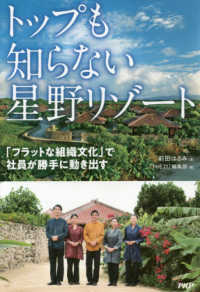- ホーム
- > 洋書
- > 英文書
- > Nature / Ecology
Full Description
This second edition focuses on Tropical Dry Forests (TDF) in the Americas and provides a comprehensive overview of new studies conducted in the last decade, giving new insights into the most endangered ecosystem in the tropics. Written by experts in remote sensing, ecosystem services, and ecology, the book concentrates on four thematic areas such as LiDAR remote sensing, remote sensing and ecology, quantification of ecosystem services, and TDF ecology. The case studies presented in this edition provide information on how emerging technologies can be applied to analyze biophysical properties and the status of TDFs across different regions in Mexico, Costa Rica, Brazil, and Bolivia.
Features
Includes all new content and does not replace the previous edition.
Offers insight into the application of airborne and terrestrial laser scanning in tropical dry forests.
Discusses ecology, remote sensing, hydrological modelling and ecosystem services.
Includes novel information to build additional comparisons with peer-reviewed datasets.
Highlights scientific achievements from different countries with tropical dry forests.
Enables readers to comprehend and apply further comparative studies within the same ecosystem.
This is an excellent book for professionals, academics, and students in the fields of Remote Sensing, Hydrology, and Environmental Science, as well as for Geographers, Ecologists, and individuals involved in the management of tropical dry forests.
Contents
Section 1: LiDAR Remote Sensing. 1. Review of LiDAR Technology in Tropical Dry Forests. 2. Simultaneous Localization and Mapping (SLAM) in Tropical Dry Forests. 3. Emergent Trees in Tropical Dry Forests Using Airborne Laser Scanning. 4. Aboveground Biomass and Biomass Change Estimates of Tropical Dry Forest Using Aerial and Terrestrial LiDAR. 5. Entropy in Tropical Dry Ecosystems. Section 2: Remote Sensing Ecology. 6. Applications of Remote Sensing in Tropical Dry Forests to Predict Biodiversity. 7. Successional Variation in Spectral and Biophysical Leaf Traits in Two Latin American Tropical Dry Forests. 8. Comparing Ground-based and Remote Sensing Methods to Assess Phenological Patterns along a Successional Gradient in a Tropical Dry Forest. 9. Deep Learning with Synergized Airborne LiDAR and Hyperspectral Data for Mapping Tropical Dry Forest Successional Stages. 10. Intra- and Interannual Variation in Tree Deciduousness in a Tropical Dry Forest in Yucatán, México: Effects of Successional Age and Topography. 11. Resilience of Tropical Dry Forests Management Systems in the Yucatan Peninsula. 12. Identifying Priority Zones for Reforestation in the Montane Dry Forests of Bolivia with Machine Learning, Remote Sensing and GIS Methods. Section 3: Ecosystem Services. 13. Environmental Drought Approach to Understanding Droughts in Tropical Dry Forests: A Review. 14. Assessing Water Ecosystem Services in the Conservation Area of Guanacaste, Costa Rica: A Hydrological Modeling Approach Integrating Land Use and Ecosystem Dynamics. 15. Quantifying Water Provisioning Services at the Guanacaste Conservation Area, Costa Rica. Section 4: Ecology. 16. Additive Partitioning of Phyllostomid Bat Diversity in Seasonally Dry Tropical Forests in Minas Gerais State, Southeastern Brazil. 17. Nutrient Deposition Dynamics along a Dry Forest Chronosequence in the Brazilian Semi-Arid Region. 18. Unravelling the factors influencing floristic composition: Insights from a local-scale study in Seasonally Dry Tropical Forests.








